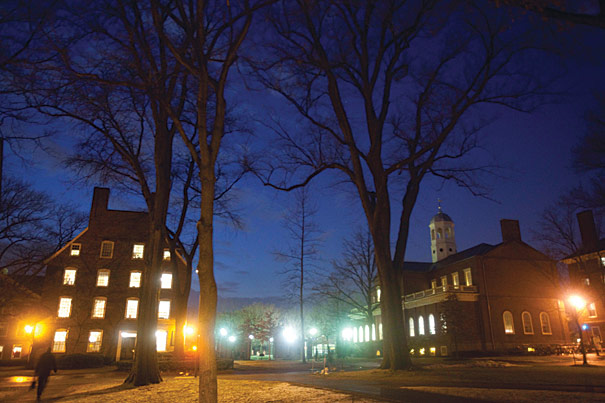
Starting in 1636, Harvard officials decided structure by structure what to construct. But somewhere along the way, the built environment began to have a reverse effect, influencing how faculty, students, and staff behaved and interacted in daily life. The resulting campus developed what could be called “the Harvard look.”
Photo details by Stephanie Mitchell/Harvard Staff Photographer
The art of architecture
Harvard’s campus reflects three centuries of architectural history
Harvard is muted red bricks and mortar. That’s its public image. But look around, and you’ll quickly see many campus buildings made of wood, granite, marble, concrete, steel, and glass.
While the brick buildings of the Yard and the Neo-Georgian river Houses depict the expected image of ivy classicism, the University actually has a sweeping range of building styles that, taken together, amount to an informal history of American architecture. A walker can sample almost 300 years of innovative designs in an easy stroll.
Harvard’s eclectic architectural mix helps to explain its values, its academic priorities, its responses to new teaching methods, its desire for stronger collaboration, its embrace of the urban environment, and its ongoing flexibility. Starting in 1636, Harvard officials decided structure by structure what to construct. But somewhere along the way, the built environment began to have a reverse effect, influencing how faculty, students, and staff behaved and interacted in daily life. The resulting campus developed what could be called “the Harvard look.”
Gilded buildings Kris Snibbe/Harvard Staff Photographer
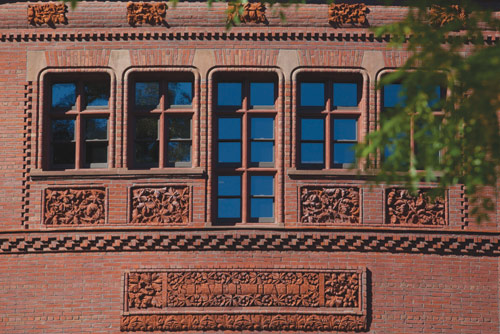
Sever Hall
Completed in 1880, Sever Hall is the product of the noted architect and Harvard alumnus Henry Hobson Richardson. Using his bold, Romanesque style, Richardson crafted Sever of red brick, but also incorporated lush ornamentation into his design.
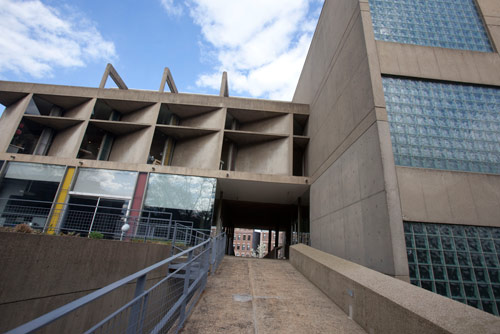
Carpenter Center
In 1963, Le Corbusier, another famed architect, added the shock of the modern to Quincy Street, where his Carpenter Center for the Visual Arts opened in counterpoint to the grand, brick Fogg Museum next door.
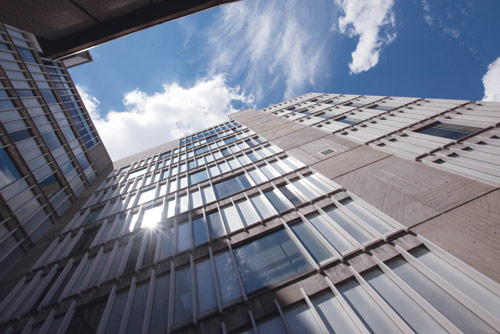
Holyoke Center
Inside and outside Sert’s Holyoke Center, shops and restaurants contribute to a lively streetscape.
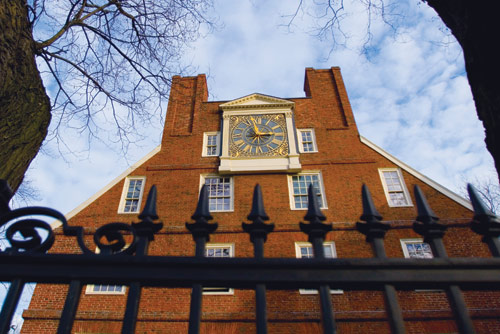
Massachusetts Hall
Among Harvard’s roughly 660 buildings, Massachusetts Hall is the oldest. Early Georgian in style, its simple construction, symmetry, and modest accents — like its belt course, a row of raised bricks that run along the façade — make it an architectural favorite of many critics.
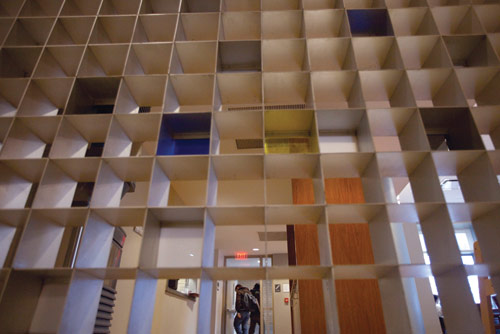
Harkness Commons
Famed architect Walter Gropius, founder of the Bauhaus school, designed the Harvard Graduate Center, now known as Harkness Commons, a cluster of buildings that became the first modernist structure on campus.
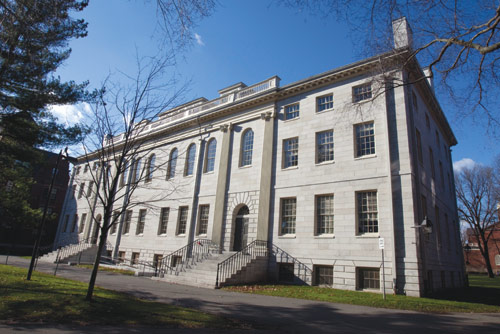
University Hall
University Hall was designed by acclaimed architect and Harvard graduate Charles Bulfinch in 1813.
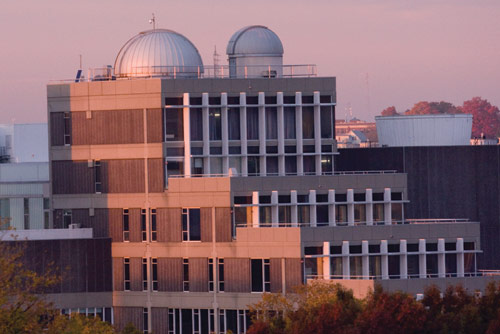
Science Center
Former GSD Dean Josep Lluis Sert designed the Science Center, seen here, against a pink sky.
“There is a quality of intimacy and adaptability about the Harvard campus that clearly distinguishes it from other universities,” said Andrea Leers, former director of the Master in Urban Design degree programs and adjunct professor of architecture and urban design at Harvard’s Graduate School of Design (GSD).
Leers, who has worked on Harvard projects that included expanding the Science Center and the New College Theatre, said, “The different styles of architecture within the continuity of the Harvard campus fabric speak of the directness, richness, and diversity of the intellectual life of the campus … The flexibility of attitudes about the architecture of Harvard reflects its fundamental spirit of openness and inquiry.”
“Buildings in any academic institution both represent and enable its aspirations and activities,” said GSD Dean Mohsen Mostafavi. “Many of the buildings at Harvard are distinctive pieces of architecture. They represent the University as a world-class institution, but in an understated manner.”
Harvard has no glassy campus pond or placid central green, like many universities do. The Yard, which is the closest thing to a traditional campus green, is dotted with buildings. The tight-knit closeness of the University’s structures, the breadth of their styles, the pocket greenery, and the bustling, untamed public square at Harvard’s core make it an unusual campus, one where faculty and students have to interact regularly.
In recent decades, buildings are even being designed so their interiors spur academic interaction. The GSD’s Gund Hall, designed by Australian architect and GSD graduate John Andrews and finished in 1972, shows how the University’s pedagogy is enhanced by a building’s design, said Mostafavi, who is also the School’s Alexander and Victoria Wiley Professor of Design.
“The hall’s open floor plan provides an extraordinary opportunity for cross-fertilization and collaboration between different disciplines,” he said, “and promotes an unusual degree of interaction, which would be harder to attain within separate enclosed spaces or rooms.”
In the northwest corner of campus, construction continues on a new Harvard Law School (HLS) building that will contain multifunctional cluster classrooms with swiveling chairs that will allow for small group chats, or class discussions, or lectures, depending on what’s needed for the teaching at hand.
Lately, Harvard also is promoting outdoor interactivity. Last year, a clever campaign energized the Yard. The campaign invited passersby to stop and sit in brightly colored chairs, to have a snack, or to sample the arts.
“I believe people respond to the built environment both in terms of the physical design and in relation to how a space is programmed, and the resources afforded to it,’’ said Tanya Iatridis, director of the University Planning Office. “Harvard Yard, the iconic heart of the campus, for all its virtues, does not maximize its potential as simply a place to walk through without stopping.”
“Inviting, gathering, and encouraging people to linger by introducing chairs, food kiosks, and arts performances in the Yard, as was carried out through the Common Spaces initiative, transformed daily interactions on the campus,” she said.
Over time, the college that was founded on the edge of the American wilderness has adapted to suit its growth and new academic needs. Early on, the campus was a contained group of buildings in a garden setting. Think Massachusetts Hall, which was completed in 1721.
In the early 1800s, University Hall broke from tradition when it was built of white granite on a site across from Massachusetts Hall. The new building material was a dramatic departure from the customary brick, and the building’s central location helped to shape future development of the Yard.
As the 20th century dawned, Harvard extended its physical reach to the Charles River, where the first undergraduate Houses opened an era of iconic views and public engagement.
In the 1950s, Harvard broke from its classical look. Famed architect Walter Gropius, founder of the Bauhaus school, designed the Harvard Graduate Center, now known as Harkness Commons, a cluster of buildings that became the first modernist structure on campus.
In 1963, Le Corbusier, another famed architect, added the shock of the modern to Quincy Street, where his Carpenter Center for the Visual Arts opened in counterpoint to the grand, brick Fogg Museum next door. By 1965, the glass and concrete face of GSD Dean Josep Lluis Sert’s 10-story Holyoke Center rose over Harvard Square.
A decade ago, Harvard embraced a new ethic of environmental sustainability. Often, the result of that shift has meant refurbishing rather than building. Think the Landmark Center in Boston, a portion of an old Sears Building that the Harvard School of Public Health (HSPH) converted to modern green standards.
Architectural shifts over time
Among Harvard’s roughly 660 buildings, Massachusetts Hall is the oldest. Early Georgian in style, its simple construction, symmetry, and modest accents — like its belt course, a row of raised bricks that run along the façade — make it an architectural favorite of many critics.
“Never was there a better example of how a simply conceived, plainspoken building of hardly any pretension can achieve a distinction that time and again eludes more elaborately contrived efforts,” wrote Douglass Shand-Tucci, a historian of American art and architecture, in his book “The Campus Guide: Harvard University.”
Massachusetts Hall has been a residence, classroom space, a barracks during the American Revolution, the home of an informal observatory, and the precursor to the modern laboratory (the “Apparatus Chamber” that included equipment acquired by Benjamin Franklin). Today it contains the offices of Harvard’s president and top administrators, with a dormitory for freshmen on its top floor.
“This is very unusual cross programming,” said Mostafavi of the hall’s dual function as office and residence. “Because it’s a House, it’s not really a building that represents power. The fact that the president is in a relatively modest building says something about the priorities and the values of the University.”
Nearby, Tercentenary Theatre, Harvard’s outdoor arena in the Old Yard that is used for social gatherings and senior send-offs, is bounded by four examples of building diversity: Memorial Church, Sever Hall, University Hall, and the colossal Widener Library.
Completed in 1880, Sever Hall is the product of the noted architect and Harvard alumnus Henry Hobson Richardson. Using his bold, Romanesque style, Richardson crafted Sever of red brick, but also incorporated lush ornamentation into his design.
“Look at how deep the walls are, the decorations around the windows, and the specially shaped brick, and the building’s texture and shadows, its dramatic roof,” said Alex Krieger, professor in practice of urban design, while touring the Yard. “There’s an incredibly voluptuous quality to it.”
Sever faces iconic University Hall, designed by acclaimed architect and Harvard graduate Charles Bulfinch in 1813. His use of white marble in a Colonial Revival and Federal style set it apart. Its placement “established the scale of the Yard and gave it visual coherence,” wrote Bainbridge Bunting in the book “Harvard: An Architectural History,” co-authored with Margaret Henderson Floyd. Instead of facing out toward the adjacent street, “the college now began to develop a spacious academic precinct facing inward, with Bulfinch’s building at its core.”
The edges of the Old Yard allow for glimpses of the modern era. Through the centuries, campus planners chose not to fully enclose the Yard like the cloistered designs of their predecessors in England, the universities at Oxford and Cambridge. Instead, the planners left gaps, allowing those passing through to see what Krieger called “a promise of something else.”
“You are always walking in a diagonal, you are always seeing the next space beyond,” said Krieger. “Over the tops of these old and venerable buildings, you see the peak of the Science Center or Memorial Hall. It is a wonderful urban design idea. It gives you a sense of what lies beyond.”
“What is very special about the Harvard campus for me,” Krieger added, “is that while it has a large, handsome, cherished, and intact historic core — which embodies the ‘Harvard brand,’ it also exhibits the confidence of each generation of its builders, building what seemed appropriate and emblematic for them.”
Wedding the old and new
Beyond the Yard is a stew of styles and designs, everything from the concrete and glass of the Science Center to the adjacent ornate brick and slate of the High Victorian Gothic Memorial Hall. On the HLS campus, Richardson’s Romanesque Austin Hall sits next to the small Greek Revival Gannett House. At Harvard Divinity School, the Collegiate Gothic-style Andover Hall is across the street from Sert’s Center for the Study of World Religions, designed as a modest residential space with an open courtyard.
Increasingly, the University’s construction projects are merging the old and the new. The renovation and expansion of the Harvard Art Museums is an example of that important nexus. Italian architectural luminary Renzo Piano’s design will unite the Fogg, the Busch-Reisinger, and the Arthur M. Sackler museums in one building. The project will preserve the skeleton of the original 1927 Fogg Museum structure and its beloved interior Calderwood Courtyard. But the new addition will be modern, with a largely wooden exterior.
Additional gallery space, classrooms, a lecture hall, and expanded study areas and conservation laboratories in a new glass structure on the roof will increase access to the collections, enhance curatorial collaboration, and broaden the museums’ role in the undergraduate curriculum. Project planners carefully positioned the new addition to the roof so the façade of the building, as viewed from the Yard, will look largely unchanged.
“It will be a very handsome and clear presentation of how you can add to an old, venerable building,” said Krieger.
Next door, the Carpenter Center, a sweeping circle and square of concrete bisected by a prominent ramp, raised eyebrows and ire when it was built in the 1960s. It is the only building in the nation by Le Corbusier, the working name of revered architect Charles-Édouard Jeanneret. While some early critics balked at the placement of such a modern work between the stately Faculty Club and the Fogg, over time the structure has taken on an almost mythic status.
Part of the center’s allure, said Elizabeth Padjen, a GSD graduate, is in its ability to act as a counterpoint. “The Carpenter Center introduced a generation to new ideas about modernity and the modern era as a whole,” said Padjen, editor of the quarterly publication of the Boston Society of Architects. “Many people on campus at that time had never seen anything like it. It still serves as a reminder that universities have a special, somewhat complicated responsibility to the culture at large, an obligation to nurture innovation even while they are increasing our understanding of the past.”
The man responsible for bringing in Le Corbusier left his own strong modernist mark on Harvard. Using concrete as an expressive material, Sert furthered modernism. The Science Center and Peabody Terrace are his creations, as is the Holyoke Center. Some critics dislike the scale, the contrasts, and the coolness of Sert’s work, but others note that the buildings neatly fill out Sert’s larger vision.
“It’s important to note that the Sert buildings were conceived as pieces in the larger master plan that he had developed for the campus,” said Hashim Sarkis, GSD Aga Khan Professor of Landscape Architecture and Urbanism in Muslim Societies.
Sert envisioned a campus where educational buildings could become an integral part of the urban environment. The Holyoke Center was developed with that in mind. It is recessed from the street, allowing Harvard Square to have more open space, a feature that was repeated on the other side of the building. The interior ground-floor passageway, a favorite motif for Sert, acts as an urban thoroughfare. Inside and outside the center, shops and restaurants contribute to a lively streetscape.
Harvard’s recent architectural past involves other projects lauded by some and criticized by others. Peabody Terrace, the 1960s graduate housing complex along the Charles River, was a University attempt to meld with the community. But some neighbors condemned the project for its scale. Similarly, detractors complained that the contemporary, boxlike dorm across the river at Harvard Business School (HBS) is too big and doesn’t fit their vision of Harvard. Over the years, the University has worked to involve the community in the design process.
Time has a way of softening such strong opinions. As decades pass, the styles that seemed overly aggressive or even distasteful in their day can come to be appreciated.
In a 1904 letter, author and emeritus Professor Charles Eliot Norton bitterly complained to Harvard’s Board of Overseers about “a long series of failures in the buildings of the University.”
“There is, perhaps, not a single University building of the last fifty years, from the Museum of Comparative Zoology to the Memorial Hall … that is likely to be held in admiration one or two generations hence,” Norton wrote.
Going green, and collaborating
In the new millennium, the University is greening the Crimson campus, with additions ranging from a building heated by underground wells, to wind turbines on rooftops, to solar panels attached to dormitories.
Rising along Massachusetts Avenue is the University’s newest building, which will serve as a Law School student center, classrooms, and clinical space. Project planners expect to win LEED Gold Certification from the U.S. Green Building Council.
Designed by Robert A.M. Stern Architects, the building also incorporates some design elements familiar to the HLS campus, including a color similar to that of Langdell Hall and prominent arches reminiscent of Austin Hall. With its green-building efficiencies, inventive classroom concepts, and a design that is modern but includes influences from the past, the building suggests an important future architectural direction for Harvard.
There have been architectural shifts beyond the main campus as well. In 1999 the Harvard School of Public Health wanted to expand in the Longwood Medical Area of Boston, but space was lacking. So when some opened in the nearby Landmark Center, a large art deco building built in 1929, the School took over more than 40,000 square feet of office space, and turned it into the University’s first sustainable building effort.
A third repurposed site signals a collaborative and interdisciplinary approach. At HBS, in a building that was once the home of public broadcaster WGBH, plans are under way for a new type of laboratory. The Harvard Innovation Lab will serve as a University-wide resource for students and faculty eager to tap into Harvard’s entrepreneurial spirit.
“We are trying to achieve a new model of collaboration for Harvard. Here, students and faculty from all across the University can meet others who share an innovative streak, who are interested in getting projects off the ground,” said Sharon Black, HBS director of planning.
The lab will include a mix of innovation-oriented and social enterprise projects, as well as services geared toward small businesses and entrepreneurs in the surrounding community.
“The future intellectual direction of Harvard will be linked to its physical planning and architectural path,” Mostafavi said.
“When there is more and more discussion around collaboration and transdisciplinary practices, the question is: What kind of space do you need for that work?” he added. “New kinds of research means new kinds of juxtapositions, and will require certain negotiations between schools. It will be important to explore how buildings and architecture can help set the stage for these future collaborations.”




